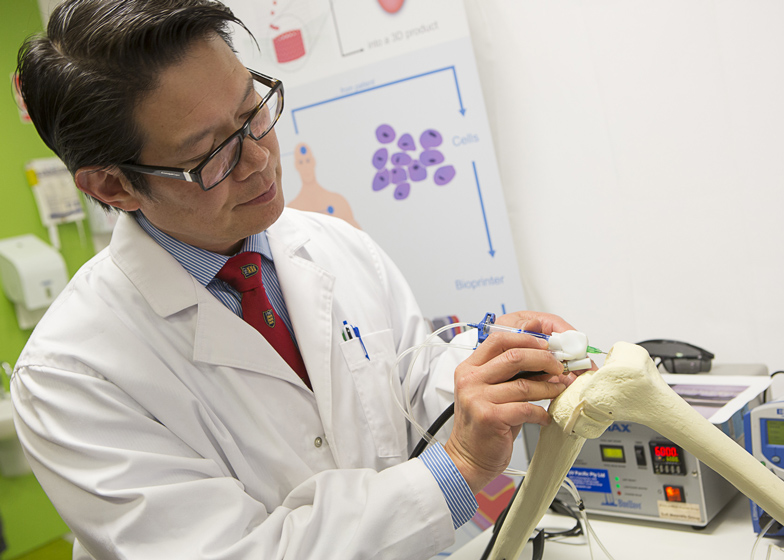News: researchers in Australia have developed a pen to deposit regenerative stem cells onto damaged bone and cartilage in a process similar to 3D printing.
The BioPen was created in the laboratories of the Australian Research Council Centre of Excellence for Electromaterials Science (ACES) at the University of Wollongong in New South Wales. It combines principles from 3D printing with stem cell research to enable missing or diseased bone to be replaced faster and more accurately.
The device extrudes cell material in a biopolymer such as seaweed extract, combined in the nozzle with a second layer of protective gel, so the surgeon can fill in areas where bone or cartilage is missing by "drawing" across the surface.
In a process similar to 3D printing, the material is deposited in layers. Each layer is exposed to ultraviolet light from a source attached to the pen, hardening the gel so further layers can be added, eventually building a three-dimensional framework.
The protective gel gradually degrades as the cells it contains begin to multiply and grow into new tissue to repair the damaged area. An additional polymer layer can be added to increase the structural strength of the material within the wound, while drugs that stimulate cellular growth or aid recovery can also be added to the cell-loaded material.
The key benefit of the handheld technique over the current process of injecting stem cells into the injury site is that surgeons have more control over where to deposit the cell-loaded material and can create customised implants as they work, speeding up the process and reducing the amount of time the patient spends in surgery.
"This type of treatment may be suitable for repairing acutely damaged bone and cartilage, for example from sporting or motor vehicle injuries," said Professor Peter Choong, BioPen co-developer and director of orthopaedics at St Vincent’s Hospital Melbourne. "Professor Wallace's research team brings together the science of stem cells and polymer chemistry to help surgeons design and personalise solutions for reconstructing bone and joint defects in real time."
The researchers at ACES have now passed the BioPen on to Professor Peter Choong, who will head a team working on refining the cell material ahead of clinical trials.
"The combination of materials science and next-generation fabrication technology is creating opportunities that can only be executed through effective collaborations such as this," said ACES director Professor Gordon Wallace.
Photography is by Mark Newsham from the University of Wollongong.
Here are some more details about the project:
BioPen to rewrite orthopaedic implants surgery
A handheld "bio pen" developed in the labs of the University of Wollongong will allow surgeons to repair damaged and diseased bone material by delivering live cells and growth factors directly to the site of injury, accelerating the regeneration of functional bone and cartilage.
Researchers from the UOW-headquartered Australian Research Council Centre of Excellence for Electromaterials Science (ACES) have developed the prototype BioPen that will give surgeons greater control over where the materials are deposited while also reducing the time the patient is in surgery.
Delivery of stem cells and/or growth factors into the injury site is currently through injection of a biomaterial carrier.
The BioPen works similarly to 3D printing methods by delivering cell material inside a biopolymer such as alginate, a seaweed extract, protected by a second, outer layer of gel material. The two layers of gel are combined in the pen head as it is extruded onto the bone surface and the surgeon "draws" with the ink to fill in the damaged bone section.
A low powered ultra-violet light source is fixed to the device, allowing for the inks to be cured during dispensing and built up layer-by-layer. Following curing, the shell material will maintain its form, and allow the surgeon to construct a 3D scaffold in the wound site.
The composition of the cell-loaded material also provides greater protection and retention of cells in the wound site and can be surrounded by a polymer core to add structural strength to the surgical site. It can also be seeded with growth factors or other drugs to assist regrowth and recovery.
All components in the implantable material are non toxic and tuned to degrade as the cells begin to populate and remodel the injured bone area. The design of the device allows it to be easily transported and the surgeon can operate with ease and precision in theatre.
The BioPen prototype was designed and built using the 3D printing equipment in the labs at the University of Wollongong and was this week handed over to clinical partners at St Vincent's Hospital Melbourne, led by Professor Peter Choong, who will work on optimising the cell material for use in clinical trials.
The BioPen will help build on recent work by ACES researchers where they were able to grow new knee cartilage from stem cells on 3D-printed scaffolds to treat cancers, osteoarthritis and traumatic injury.
Professor Peter Choong, Director of Orthopaedics at St Vincent's Hospital Melbourne and the Sir Hugh Devine Professor of Surgery, University of Melbourne said: "This type of treatment may be suitable for repairing acutely damaged bone and cartilage, for example from sporting or motor vehicle injuries. Professor Wallace's research team brings together the science of stem cells and polymer chemistry to help surgeons design and personalise solutions for reconstructing bone and joint defects in real time."
The BioPen will be transferred to St Vincent’s for clinical projects to be carried out at the proposed Aikenhead Centre for Medical Discovery in Melbourne.
"The combination of materials science and next-generation fabrication technology is creating opportunities that can only be executed through effective collaborations such as this," ACES Director Professor Gordon Wallace said. "What's more, advances in 3D printing are enabling further hardware innovations in a rapid manner."
Design expertise and fabrication of the BioPen was supported by the Materials Node of the Australian National Fabrication Facility, hosted at the University of Wollongong's Innovation Campus.

